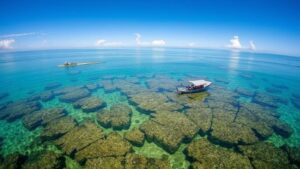Locating Gold Coins Near Historic Port Entrances and Anchor Points
Locating Gold Coins Near Historic Port Entrances and Anchor Points
The lure of gold coins has enchanted treasure hunters and historians for centuries. This article explores the strategic locations for finding gold coins, particularly near historic port entrances and anchor points, which have long been associated with maritime trade, naval battles, and the transportation of wealth. By understanding the historical context and employing effective searching techniques, one can enhance their chances of unearthing these precious artifacts.
The Historical Significance of Ports and Anchor Points
Ports and anchor points have served as vital hubs for commerce and military endeavors throughout history. facilitated trade routes for various empires, leading to the accumulation of wealth in the form of coins and other valuables. For example, during the height of the Spanish Empire in the 16th and 17th centuries, ports like Cartagena and Veracruz became hotspots for gold and silver shipments from the New World.
- Cartagena, Colombia: Once the main port for Spanish treasure fleets, it was known for its strategic location, often attracting pirates.
- Veracruz, Mexico: This port was central to trade and wealth accumulation, making it a prime location for treasure seekers.
As ships docked and anchored, coins frequently fell overboard, were lost during violence or theft, or were left behind by sailors. As a result, areas around ports and anchor points are prime candidates for locating lost treasure.
Archaeological and Historical Research
Before embarking on any treasure hunt, researching historical records is critical. Valuable sources include ship logs, maritime records, and accounts of naval battles, which can provide insights into where ships were likely to anchor and where accidents may have occurred. Historical maps can also be utilized to identify former port locations that may have shifted due to natural changes or urban development.
An exemplary case study is the discovery of a Spanish galleon, the Nuestra Señora de Atocha, which sank off the Florida Keys in 1622. After extensive research and exploration led by Mel Fisher, the ship was located, revealing a treasure trove of gold coins estimated to be worth over $400 million. This illustrates the importance of combining research with local knowledge when seeking lost artifacts.
Techniques for Treasure Hunting
Once potential sites have been identified, employing various techniques will significantly increase the likelihood of finding gold coins. Below are some effective methods:
- Metal Detecting: Equip yourself with a high-quality metal detector capable of distinguishing between various types of metals, particularly those detectable at greater depths.
- Water Searching: Many coins are found underwater. Using scuba gear or snorkels can be advantageous in shallow waters near historical anchor points.
- Magnet Fishing: This technique involves using strong magnets to retrieve metallic items from water bodies and has been known to recover coins tossed overboard.
For example, the use of metal detectors has gained popularity during beach and underwater searches, allowing amateur and professional treasure hunters alike to search efficiently. By focusing on historic shipping lanes and routes of shipwrecks, the potential for discovery increases.
Ethical Considerations
While treasure hunting is an exciting venture, it is essential to engage ethically in this pursuit. Many locations may be protected under maritime law, historical preservation mandates, or local regulations. Always seek proper permissions and consider reporting findings to local authorities to support historical research efforts. For example, the Florida Underwater Archaeological Preserves Act encourages preservation of wreck sites and stipulates that historic items recovered in state waters must be reported.
Following ethical practices not only enhances the integrity of treasure hunting but also contributes to preserving history for future generations.
Actionable Takeaways
- Conduct thorough research on the local history and ship routes before searching for treasure.
- Use effective techniques such as metal detecting, water searching, and magnet fishing to maximize discovery chances.
- Be aware of and comply with legal and ethical guidelines to ensure responsible exploration.
By understanding the historical context, employing effective searching methods, and following ethical practices, treasure hunters can embark on fulfilling adventures in search of lost gold coins near historic ports and anchor points. Each discovery has the potential not only to yield precious material wealth but also to contribute to a deeper understanding of our shared maritime heritage.


